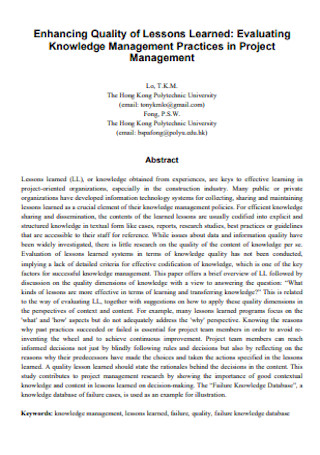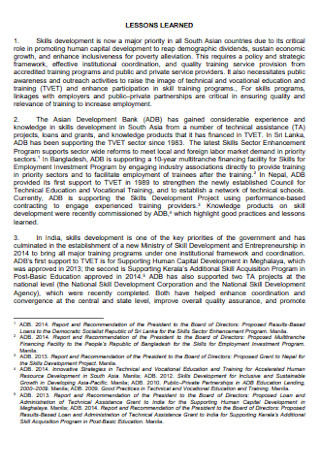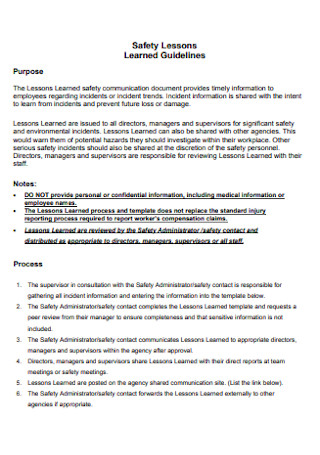40+ Sample Lesson Learned
-

Overall Life Lessons Learned
download now -

Project Management Lessons Learned Log
download now -

Clip Art Lessons Learned Format
download now -

Lessons Learned quote Paper
download now -

Enhancing Business Quality of Lessons Learned
download now -

Sample Love Lessons Learnt
download now -

Valuable Lessons Learned from Patient Engagement
download now -

Simple Friendship Lessons Learned
download now -

Formal Mistake Lesson Learned
download now -

Synthesis of Deep Lessons Learned
download now -

The Little Prince Lessons Management Learned
download now -

Formal Agile Lessons Learned
download now -

Lessons No Regret Learned Survey
download now -

Construction Lessons Learned Report
download now -

School Principles of Lesson Learned
download now -

Project Lessons Learned Story
download now -

Standard Community Lesson Learned
download now -

Eleven Theme Lessons Learned
download now -

Project Managers Lessons Learning Learned
download now -

Categorizing Case Study Intelligent Lessons Learned
download now -

Study Incident Lesson Learned
download now -

Project Closure Lessons Training Learned
download now -

Lessons Learned Framework Example
download now -

Lessons Learned Programs Template
download now -

Communicating Safety Lessons Learned
download now -

Lessons Learned Leadership
download now -

Internship Safety Lessons Learned
download now -

Agriculture Lessons Learned
download now -

Lesson Develop Learned
download now -

Pandemic Lessons Learned
download now -

Army Acquisition Lessons Learned
download now -

Lessons Learned Repository for Computer
download now -

Client Project Lessons Learned
download now -

Lessons Learned Format
download now -

Assessment Lessons Learned
download now -

Corporate Lesson Learned
download now -

Standard Lessons Learned
download now -

Lessons Learned for Communities
download now -

Lessons Learned Procedure Template
download now -

Sustainability Lesson Learnt
download now -

Lessons Learned From Leadership
download now
FREE Lesson Learned s to Download
40+ Sample Lesson Learned
What Is a Lesson Learned Sample?
Processes Needed In Lessons Learned
Important Skills in the Lessons Learned Approach
Parts of a Lessons Learned
How to Create a Lesson Learned Sample
FAQs
What do you write in lessons learned?
What are examples of lessons learned in a project?
What is meant by lessons learned?
What Is a Lesson Learned Sample?
A Lesson Learned sample is an approach in project management plans that aims to analyze and apply knowledge gained from executing a particular project. It is created to maximize learning and identify areas for improvement.
According to a conference paper published by Project Management Institute (PMI), the lessons learned sample strategy is important because project teams need to be able to learn from project failures as well as project successes.
Processes Needed In Lessons Learned
Important Skills in the Lessons Learned Approach
Parts of a Lessons Learned
The lesson learned approach is typically used in project management or program implementation. However, the content and format can vary from industry to industry. The field of project management heavily relies on process; and spends a great deal trying to refine and perfect the process. Some of the basic parts of a lesson learned sample include the following:
How to Create a Lesson Learned Sample
The good thing about the lessons learned approach is that you can tailor fit it to your company’s needs and goals. The collaborative effort it demands means that all ideas are welcome and it is only a matter of sifting through these and choosing which ones to focus on. The step-by-step guide below will help you lay the groundwork for creating a successful lessons learned output:
Step 1: Establish the Format
It is important to decide on a format that will maximize the ideas and lessons gained. You could create an Excel spreadsheet or checklist, a power point presentation, a summarized report, or even an initial questionnaire that provides feedback about the project. But most teams find a simple table convenient and easy to follow. You could create any table using the basic MS applications. If your team is required to gather for a post-event processing session, then an engaging power point presentation with interesting pictures could work well. Using the right format is essential because it sets the flow of your discussion and keeps the agenda focused.
Step 2: Brainstorm Ideas and Lessons
Sitting down with the team is of utmost importance. It lays the ground for feedback and the discussion naturally flows when people bounce off ideas from each other. It opens the space for people to air their grievances of what went wrong and credit the achievements of what went right. Brainstorming is best conducted right after a project or event has wrapped up. The ideas and issues are still fresh and are likely to be retained and remembered accurately. A brainstorming session may be as simple as a team gathered together with a whiteboard or a more complex session involving standardized survey forms and questionnaires. It’s important to note that lessons may not be immediately learned unless there is openness and honest feedback coming from the team. Thus, creating an environment conducive to learning is critical.
Step 3: Write Down Lessons Learned
Gradually fill in your table or slide, depending on your chosen format. Discuss as a team and process your information and insights together. Evaluating the project may initially seem like a dragging or drawn out task; which is why brainstorming is important because only then can you start organizing and analyzing the information. It’s best to do this right after a project is completed, in order to gather as much information as possible. Try arranging your items according to significance or greatest impact. Some items may have sub ideas or secondary lessons and it’s good to plot that out too in your table.
Step 3: Assess the Positives and Negatives
After identifying and enumerating the insights, then comes the judgment. The key here is to keep an open yet objective view. Once you have a good idea of the overall success (or lack thereof) of the project, you can more or less assess and decide if a particular aspect was successful or could have turned out differently. What worked and delivered the desired results? This can be a positive indicator. On the other hand, what was implemented but did not meet the goal? This could be a negative indicator. But in order to do this, you would need some form of metrics or a concrete way to measure the success or failure. Setting the goals and targets is often done in the planning stage. These need to be set prior to actual implementation of the project. It will then serve as a reference point for you to measure it against the actual lesson learned. An example of this would be key performance indicators or KPIs that companies use to quantify performance and success.
Step 4: Give Recommendations and Plot the Next Steps
The notion that theory is only good if it is applied and practiced rings true here. Assessment and judgment would be meaningless without concrete action. Once you have identified both the strengths and flaws, recommend better strategies and come up with realistic solutions in order to do better next time. Outline the next steps and create an effective tracking strategy to ensure a proper follow-through. Using the lessons you learned, you can be more confident and optimistic in tackling the next project, then the next. The only thing left to do is to commit to an improved version of the project and strive for a better execution using the insights gained during the session analysis.
Step 5: Document the Output
To wrap up your learning session, it is helpful to have a designated person who can dutifully organize all the information. Documentation is crucial because your analyses and insights need to be within reach, if ever the need for it again arises. Having it on file could also serve other teams who may need access to the output.
FAQs
What do you write in lessons learned?
The key is drawing from experience and being able to organize insights and lessons for the purpose of applying them in concrete ways. It would consist of the team’s targets, KPIs, results, and overall learnings. Most lesson learned templates include an action column where suggestions and solutions to problems are listed.
What are examples of lessons learned in a project?
Picture a project team of engineers. The group just finished topping off a high rise building. Preparations for the event took nearly three weeks to finalize. The next day, the lead engineer calls a team meeting to discuss the recently concluded event. During the meeting, a civil engineer points out a blunder wherein several floors were not cleaned and removed of debris. The lesson learned prompted the team to always keep an inspection checklist and assign a member to conduct final rounds, hours prior to the event.
What is meant by lessons learned?
Lessons learned is simply learning from experience. In a lot of ways, most successful programs are a result of trial and error. Especially if a project is new territory, it gives the team a lot of room to learn and come up with their own standard operating procedures and best practices. Further, this commitment to excellence and insatiable quest for constant growth and improvement is what fuels the lesson learned strategy.
If we were to believe Albert Einstein’s theory of insanity, how then can we guarantee or, at the very least, minimize the likelihood of repeating our mistakes? What can companies do to ensure continuous learning and sustained growth? In the area of project management, processes make up the bulk of the work. The lessons learned approach offers the opportunity to constantly learn and improve on those processes. Try any template above and craft your own lessons learned sample today!
